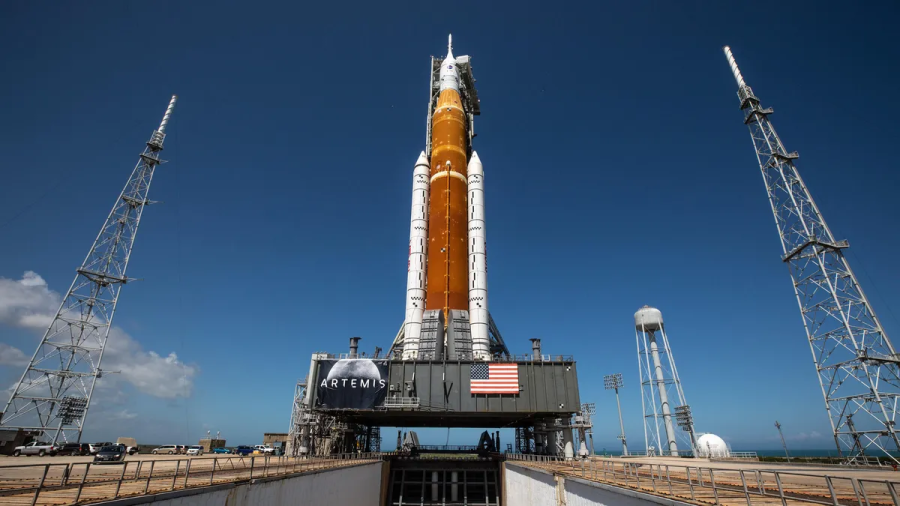Off to Space with Artemis I
The SLS (Space Launch System), pictured above, will carry the Orion spacecraft in Artemis I. Credit: Kim Shiflett/NASA
October 14, 2022
The Apollo program ended almost exactly fifty years ago, having left an enduring mark on history. For the first time, man had stepped on the Moon. Now, NASA and three other space agencies hope to replicate the miracle and go even further with the Artemis program.
Artemis represents the mission of NASA, the Canadian Space Agency (CSA), and the Japanese Aerospace Exploration Agency (JAXA), to establish a base on the Moon and demonstrate new technologies, study the solar system further, and expand the global economy to the Moon. The first of these missions is Artemis I, a test flight of an unmanned spacecraft to and from the Moon. A rocket called the Space Launch System (SLS) will be the spacecraft’s ride out of the atmosphere. The rocket will be 322 feet tall, making it slightly shorter than the Saturn 5 rocket that delivered the Apollo astronauts to the Moon; in return, though, it is 15% more powerful than its predecessor, producing 8.8 million pounds of thrust at launch. The European Service Module, a module that carries solar panels, fuel tanks, and life support systems, will also travel with the spacecraft.
The spacecraft itself is named Orion, a capsule designed to house humans on voyages to the Moon and keep them healthy on the way. For now, however, it will simply fly past the Moon and back to Earth on a six-week journey, reentering the atmosphere at Mach 32.
The mission was planned to launch on August 29, 2022 at the Kennedy Space Center in Florida, but an engine problem delayed the launch. Then, due to various engineering problems and unfavorable weather conditions (including, most recently, Hurricane Ian), the launch was continuously delayed. It is currently set to launch in mid-October.
Later, on Artemis II, Orion will carry astronauts in its journey to the Moon, although they will still not land. That will happen on Artemis III, where the astronauts will use a modified version of the SpaceX’s Starship to land on the lunar south pole, as Orion is not capable of landing. One of the Artemis Programs’ stated goals is to “land the first woman and the first person of color on the Moon”.
It also aims to establish a space station around the Moon, called the Lunar Gateway, which will provide space for its crew to work and live, docking ports for other spacecraft, and an area in which to perform experiments on heliophysics, Earth science, astrophysics, lunar sciences, and life sciences. During further manned missions to the Moon’s surface, astronauts will require cargo and supplies, which will be delivered to the Gateway.
After Artemis, the next step will be to use the supplies and knowledge gained from the mission to continue on to Mars by the 2030s. If they succeed in that mission, we will live to see one of the most important events in the history books of the future.
References:
- “Artemis I.” NASA, https://www.nasa.gov/specials/artemis-i/. Accessed 30 September 2022.
- “Artemis II Rocket Engines Arrive at NASA’s Michoud Assembly Facility.” NASA, 29 September 2022, https://www.nasa.gov/exploration/systems/sls/artemis-ii-rocket-engines-arrive-at-nasa-s-michoud-assembly-facility.html. Accessed 30 September 2022.
- “Gateway.” NASA, 27 June 2022, https://www.nasa.gov/gateway/overview. Accessed 30 September 2022.
- Greshko, Michael. “How NASA’s Artemis program plans to return astronauts to the moon.” National Geographic, 22 August 2022, https://www.nationalgeographic.com/science/article/how-nasas-artemis-program-plans-to-return-astronauts-to-the-moon. Accessed 30 September 2022.
- Malik, Tariq. “NASA’s Artemis 1 moon mission: Live updates.” Space.com, 28 September 2022, https://www.space.com/news/live/nasa-artemis-1-moon-mission-updates. Accessed 30 September 2022.
- “NASA Unveils Sustainable Campaign to Return to Moon, on to Mars.” NASA, 26 September 2018, https://www.nasa.gov/feature/nasa-unveils-sustainable-campaign-to-return-to-moon-on-to-mars. Accessed 30 September 2022.
- “Orion Overview.” NASA, 22 August 2022, https://www.nasa.gov/exploration/systems/orion/about/index.html. Accessed 30 September 2022.
- “What is Artemis?” NASA, 25 July 2019, https://www.nasa.gov/what-is-artemis. Accessed 30 September 2022.










